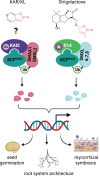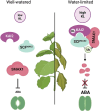Karrikin signalling: impacts on plant development and abiotic stress tolerance
- PMID: 38001035
- PMCID: PMC10860534
- DOI: 10.1093/jxb/erad476
Karrikin signalling: impacts on plant development and abiotic stress tolerance
Abstract
Plants rely upon a diverse range of metabolites to control growth and development, and to overcome stress that results from suboptimal conditions. Karrikins (KARs) are a class of butenolide compounds found in smoke that stimulate seed germination and regulate various developmental processes in plants. KARs are perceived via a plant α/β-hydrolase called KARRIKIN INSENSITIVE2 (KAI2), which also functions as a receptor for a postulated phytohormone, provisionally termed KAI2 ligand (KL). Considered natural analogues of KL, KARs have been extensively studied for their effects on plant growth and their crosstalk with plant hormones. The perception and response pathway for KAR-KL signalling is closely related to that of strigolactones, another class of butenolides with numerous functions in regulating plant growth. KAR-KL signalling influences seed germination, seedling photomorphogenesis, root system architecture, abiotic stress responses, and arbuscular mycorrhizal symbiosis. Here, we summarize current knowledge of KAR-KL signalling, focusing on its role in plant development, its effects on stress tolerance, and its interaction with other signalling mechanisms.
Keywords: Abiotic stress; butenolide; development; hormone; karrikin; photomorphogenesis; root architecture; signalling.
© The Author(s) 2023. Published by Oxford University Press on behalf of the Society for Experimental Biology.
Conflict of interest statement
The authors declare no conflicts of interest.
Figures


Similar articles
-
The Multifaceted Impact of Karrikin Signaling in Plants.Int J Mol Sci. 2025 Mar 19;26(6):2775. doi: 10.3390/ijms26062775. Int J Mol Sci. 2025. PMID: 40141418 Free PMC article. Review.
-
Karrikin perception and signalling.New Phytol. 2023 Mar;237(5):1525-1541. doi: 10.1111/nph.18598. Epub 2022 Dec 7. New Phytol. 2023. PMID: 36333982 Review.
-
Comparing and Contrasting the Multiple Roles of Butenolide Plant Growth Regulators: Strigolactones and Karrikins in Plant Development and Adaptation to Abiotic Stresses.Int J Mol Sci. 2019 Dec 12;20(24):6270. doi: 10.3390/ijms20246270. Int J Mol Sci. 2019. PMID: 31842355 Free PMC article. Review.
-
Specialisation within the DWARF14 protein family confers distinct responses to karrikins and strigolactones in Arabidopsis.Development. 2012 Apr;139(7):1285-95. doi: 10.1242/dev.074567. Epub 2012 Feb 22. Development. 2012. PMID: 22357928
-
KARRIKIN INSENSITIVE2 regulates leaf development, root system architecture and arbuscular-mycorrhizal symbiosis in Brachypodium distachyon.Plant J. 2022 Mar;109(6):1559-1574. doi: 10.1111/tpj.15651. Epub 2022 Feb 23. Plant J. 2022. PMID: 34953105
Cited by
-
Ethylene promotes SMAX1 accumulation to inhibit arbuscular mycorrhiza symbiosis.Nat Commun. 2025 Feb 27;16(1):2025. doi: 10.1038/s41467-025-57222-w. Nat Commun. 2025. PMID: 40016206 Free PMC article.
-
The Multifaceted Impact of Karrikin Signaling in Plants.Int J Mol Sci. 2025 Mar 19;26(6):2775. doi: 10.3390/ijms26062775. Int J Mol Sci. 2025. PMID: 40141418 Free PMC article. Review.
References
-
- Abdelrahman M, Mostofa MG, Tran CD, El-Sayed M, Li W, Sulieman S, Tanaka M, Seki M, Tran L-SP.. 2022. The karrikin receptor KARRIKIN INSENSITIVE2 positively regulates heat stress tolerance in Arabidopsis thaliana. Plant and Cell Physiology 63, 1914–1926. - PubMed
-
- Akiyama K, Matsuzaki KI, Hayashi H.. 2005. Plant sesquiterpenes induce hyphal branching in arbuscular mycorrhizal fungi. Nature 435, 824–827. - PubMed
-
- Arite T, Umehara M, Ishikawa S, Hanada A, Maekawa M, Yamaguchi S, Kyozuka J.. 2009. d14, a strigolactone-insensitive mutant of rice, shows an accelerated outgrowth of tillers. Plant and Cell Physiology 50, 1416–1424. - PubMed
Publication types
MeSH terms
Substances
Grants and funding
LinkOut - more resources
Full Text Sources
Miscellaneous

